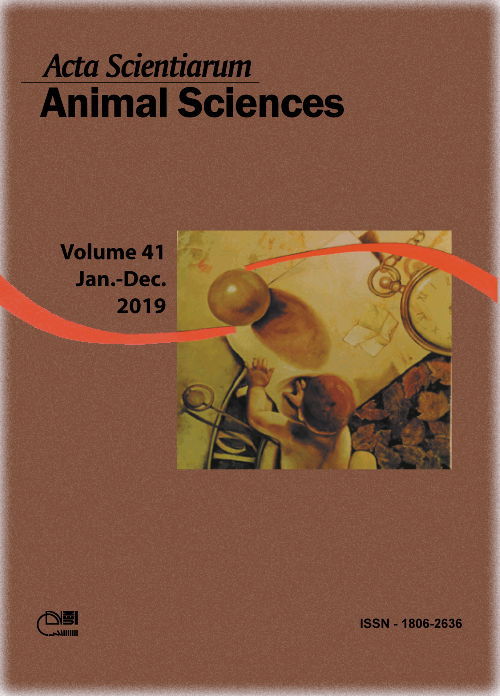Dry matter intake and milk yield of cows grazing Xaraés palisadegrass under different management strategies
Resumo
This study aimed to evaluate the intake and milk yield of crossbred cows (Holstein x Zebu), under two management strategies, based on 95% light interception and fixed days. Eight lactating cows with body weight of 466 kg (± 35 kg) and lactation stage of 137 days (± 107 days) were used, four animals were assigned to each treatment. Dry matter intake was estimated indirectly, using neutral detergent insoluble fiber as internal indicator and chromium oxide as external indicator. This was a completely randomized design, with four replications, two grazing strategies and three days of occupation. The animals under light management showed dry matter intake on the first day (11.42 kg) similar to the second day (9.57 kg), and this was similar to the third day (7.06 kg), but the intake on the first day was greater than on the third day. On the fixed days, intake did not differ between the first and second day (12.05 and 11.47 kg, respectively), and intake of the third day (6.70 kg) was lower than in the first two days. The dry matter intake in relation to the body weight of the animals presented similar results to the dry matter intake of forage in kilos, which can be explained by the small difference in weight between the mean of the groups. The individual milk yield showed a similar behavior among the grazing strategies for the days of occupation, which increased from the first to the second day (12.49 to 13.88 kg) and decreased from the second to the third day (12.20 kg). Grazing management strategies did not promote differences in the performance traits of lactating cows. The day of grazing during the period of occupation can be decisive for intake and production.
Downloads
Referências
Association of Official Analytical Chemists [AOAC]. (1995). Official methods of analysis (16th ed.). Arlington, VA: AOAC International.
Bezerra, E. S., Queiroz, A. C., Bezerra, A. R. G. F., Pereira, J. C., & Paulino, M. F. (2004). Perfil granulométrico da fibra dietética sobre o tempo médio de retenção e a digestibilidade aparente de dietas de vacas leiteiras. Revista Brasileira de Zootecnia, 33(6), 2378-2386. doi: 10.1590/S1516-35982004000900026.
Blaser, R. E., Hammes Júnior, R. C., Fontenot, J. P., Bryant, H. T., Polan, C. E., Wolf, D. D., … Moore, J. S. (1986). Forage-animal management systems. Blacksburg, VA: Virginia Polytechnic Institute and State University.
Brâncio, P. A., Nascimento Junior, D., Euclides, V. P. B., Fonseca, D. M., Almeida, R. G., Macedo, M. C. M., & Barbosa, R. A. (2003). Avaliação de três cultivares de Panicum maximum Jacq. sob pastejo: Composição da dieta, consumo de matéria seca e ganho de peso animal. Revista Brasileira de Zootecnia, 32(5), .1037-1044. doi: 10.1590/S1516-35982003000500002.
Cappelle, E. R., Valadares Filho, S. C., Silva, J. F. C., & Cecon, P. R. (2001). Estimativas do Valor Energético a partir de Características Químicas e Bromatológicas dos Alimentos. Revista Brasileira de Zootecnia, 30(6),1837-1856. doi: 10.1590/S1516-35982001000700022.
Clipes, R. C., Silva, J. F., Detmann, E., & Vásquez, H. M. (2006). Composição químico-bromatológica da forragem durante o período de ocupação em pastagens de capim-elefante (Pennisetum purpureum, Schum) e capim-mombaça (Panicum maximum, Jacq) sob manejo rotacionado. Arquivo Brasileiro de Medicina Veterinária e Zootecnia, 58(5), 868-876. doi: 10.1590/S0102-09352006000500024
Cochran, R. C., Adams, D. C., Wallace, J D., & Galyean, M. L. (1986). Predicting digestibility of different diets with internal markers: Evaluation of four potential markers. Journal of Animal Science, 63(5),1476-1483. doi: 10.2527/jas1986.6351476x.
Cóser, A. C., Martins, C. E., Fonseca, D. M. D., Salgado, L. T., Alvim, M. J., & Teixeira, F. V. (1999). Effect of different grazing periods in elephant grass pasture upon milk production. Pesquisa Agropecuária Brasileira, 34(5), 861-866. doi: 10.1590/S0100-204X1999000500018.
Ferreira, D. F. (2011). Sisvar: a computer statistical analysis system. Ciência e Agrotecnologi, 35(6), p xx-xx?. doi: 10.1590/S1413-70542011000600001.
Kimura, F.T.; & Miller, V.L. (1957). Chromic oxide measurement. Improved determination of chromic oxide in cow feed and feces. Journal Agriculture Food Chemistry, 5, 216-232. doi: 10.1021/jf60073a008.
Köppen, W. (1948). Climatologia: con un estudio de los climas de la tierra. Mexico, MX: Fondo de Cultura Econômica.
National Research Council [NRC]. (2001). Nutrient requeriments of dairy cattle (7th ed.). Washinton, DC: National Academy Press.
Sklan, D., Ashkenazi, R., Braun, A., Devorin, A., & Tabori, K. (1992). Fatty acids, calcium soaps of fatty acids, and cottonseeds fed to high yielding cows. Journal of Dairy Science, 75, 2463-2472. doi: 10.3168/jds.S0022-0302(92)78008-4.
Van Soest, P. J. (1994). Nutritional ecology of the ruminant. New York, NY: Cornell University Press.
Van Soest, P. J., Robertson, J. B., & Lewis, B. A. (1991). Methods for dietary fiber, neutral detergent fiber, and nonstarch polysaccharides in relation to animal nutrition. Journal of Dairy Science, 74(10), 3583-3597. doi: 10.3168/jds.S0022-0302(91)78551-2.
VoltolinI, T. V., Santos, F. A. P., Martinez, J. C., Clarindo, R. L., Penati, M. A., & Imaizumi, H. (2010). Características produtivas e qualitativas do capim-elefante pastejado em intervalo fixo ou variável de acordo com a interceptação da radiação fotossinteticamente ativa. Revista Brasileira de Zootecnia, 39(5), 1002-1010. doi: 10.1590/S1516-35982010000500009.
DECLARAÇÃO DE ORIGINALIDADE E DIREITOS AUTORAIS
Declaro que o presente artigo é original, não tendo sido submetido à publicação em qualquer outro periódico nacional ou internacional, quer seja em parte ou em sua totalidade.
Os direitos autorais pertencem exclusivamente aos autores. Os direitos de licenciamento utilizados pelo periódico é a licença Creative Commons Attribution 4.0 (CC BY 4.0): são permitidos o compartilhamento (cópia e distribuição do material em qualqer meio ou formato) e adaptação (remix, transformação e criação de material a partir do conteúdo assim licenciado para quaisquer fins, inclusive comerciais.
Recomenda-se a leitura desse link para maiores informações sobre o tema: fornecimento de créditos e referências de forma correta, entre outros detalhes cruciais para uso adequado do material licenciado.








































